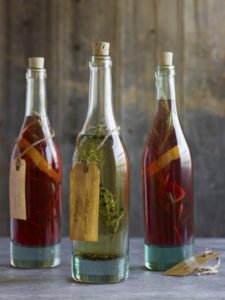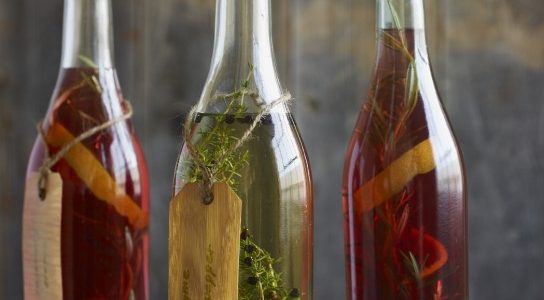Perserving Flavoured Vinegars
 Flavouring vinegar with sprigs of herbs, chiles, fruit or other seasonings makes aesthetically beautiful and tasty gifts. Here’s some considerations for perserving these vinegars and how long can these vinegars be stored.
Flavouring vinegar with sprigs of herbs, chiles, fruit or other seasonings makes aesthetically beautiful and tasty gifts. Here’s some considerations for perserving these vinegars and how long can these vinegars be stored.
- Use jars or glass bottles that are free of cracks or nicks and can be sealed with corks, screw-band caps or two-piece canning lids. Use clean, sterilize jars or bottles by completely immersing them in water and boiling for 10 minutes. Remove the jars or bottles from the water and invert on a clean towel. Fill the jars with your vinegar while they are still warm.
- If using screw caps, wash in hot soapy water, rinse and leave caps in the hot water until ready to use. If using corks, select new, pre-sterilized corks. Use tongs to dip corks in and out of boiling water 3-4 times. If using two piece canning jar lids, allow enough headspace between the lid and the vinegar so that there is no contact between them. Plastic storage screw caps that are made for canning jars work well for flavored vinegars.
- Use very fresh herbs, allowing 3 to 4 sprigs per pint (2 cups) of vinegar.
- Allow 1 to 2 cups of fruit per pint of vinegar, or the peel of one orange or lemon per pint of vinegar. Garlic cloves, peppers and chunks of firm fruit may be threaded on clean, thin bamboo skewers for easy insertion and removal.
- Several types of vinegar may be used, but not all give the same results. Distilled white vinegar is clear in color and has a sharp acidic taste by itself. It is the best choice for delicately flavored herbs. Apple cider vinegar has a milder taste than distilled white vinegar, but the amber color may not be desirable. Apple cider vinegar blends best with fruits. White wine and champagne vinegars work well with delicate herbs and lighter-flavored fruits. Red wine vinegar will mask the flavor of most herbs except for rosemary perhaps. Rice vinegar is a mild, slightly sweet vinegar. Be aware that wine and rice vinegars contain some protein that provides an excellent medium for bacterial growth, if not handled and stored properly.
- To flavour the vinegar, heat the vinegar to just below the boiling point. Pour over the flavoring ingredients in jars, leaving 1/4 inch headspace. Attach lids, corks or screw caps tightly. Let sit in a cool, dark place undisturbed for 3 to 4 weeks to develop flavors. Strain the vinegar one or more times until the vinegar shows no cloudiness. Discard the fruit, vegetables and/or herbs. Pour the strained vinegar into clean sterilized jars and cap tightly. A few clean berries or a washed and sanitized sprig of fresh herb may be added to the jars before closing, if desired.
- Store the flavored vinegars in a cool, dark place. Refrigeration is best for retention of freshness and flavors. Date the bottles or jars when they are opened. If properly prepared and bottled, flavored vinegars should keep for up to 3 months in cool storage.
As long as clean and high-quality ingredients (vinegar and herbs, vegetables or fruits) are used, the greatest concern with homemade flavored vinegars should be mold or yeast and then having to throw out your product. If your flavored vinegar starts to mold at any time, or show signs of fermentation such as bubbling, cloudiness or sliminess, discard the product and do not use any of it that is left.
This information is taken from the National Centre for Home Food Preservation. The full article for further detail and vinegar flavouring ideas, can be found at Flavoured Vinegars.



Comments are closed.